Western Digital RAID Edition (RE) 4TB Enterprise drive takes the RE family to the 4TB capacity limit. The new drive offers a SATA 6Gbps interface with RAID-specific, time-limited error recovery (TLER), dual actuator technology, enterprise build quality to name a few of the features that make the Western Digital RE’s ideal for Enterprise users looking for the fine balance between performance and capacity.
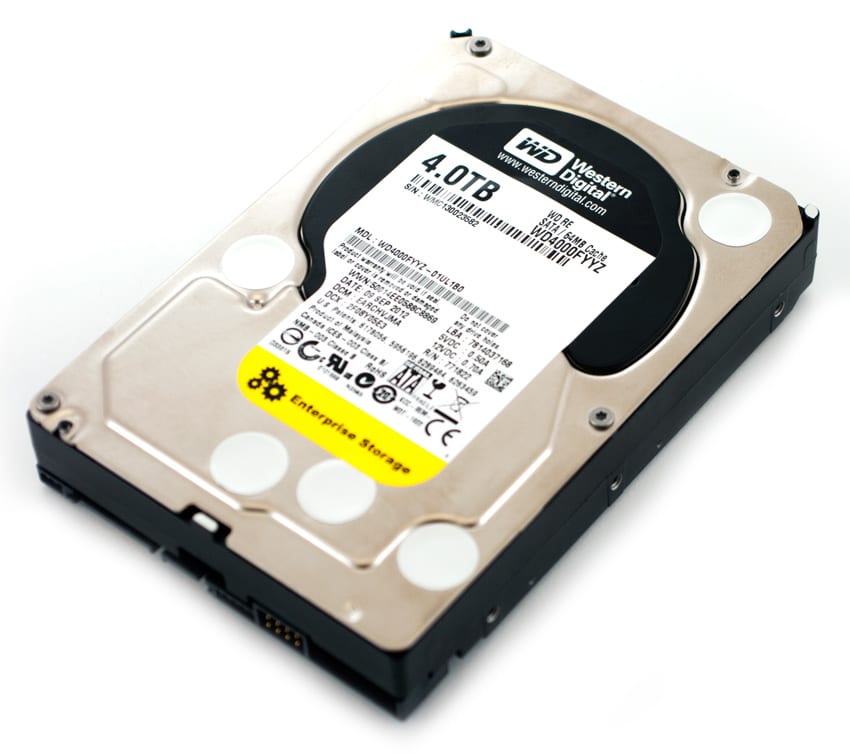
With 4TB capacity, these drives are ideal for bulk storage duties, such as JBODs, compute servers, video surveillance and other demanding write-intensive applications. With Western Digital’s stated field-tested 1.2 million hour MTBF, the drive is expected to deliver the highest level of reliability for 24×7 operations. To build upon the reliability, Western Digital puts the drives through extended burn in testing with thermal cycling to ensure reliable operation. This reliability is what allows Enterprise have confidence and security that their operations won’t be effected by data failures or drive failures that could cripple an operation.
Western Digital offers three Enterprise class drives to their consumers, RE – SATA 6Gbps & 3Gbps, RE – SAS 6Gbps and Xe – SAS 6Gbps. Both the RE classes are a 3.5″ form-factor and range from 250GB to 4TB capacities. The Xe class, which is an Ultra-fast SAS drive, comes in 300GB to 900GB capacities. The Western Digital RE 4TB stands at top of Enterprise class capacities for Western Digital.
With the growing trend toward Cloud-based servers, companies are looking for more and more higher capacity drives and the manufacturers are responding with 4TB capacities and rumored 6TB to 8TB drives down the road. The market is already filled with offerings from Hitachi, Seagate and Toshiba in 4TB capacities, so look for us to have reviews of these down the road.
Western Digital RE 4TB Enterprise Specifications (WD4000FYYZ)
- Capacity: 4TB
- Interfaces: SATA 6Gbps
- Sustained Sequential Transfer Speed: 171MB/s
- User Sectors Per Drive: 7,814,037,168
- Physical Dimensions: Height 1.028 Inches, Depth 5.787 Inches, Width 4.00 Inches
- Operating Shock (Read): 30G, 2 ms
- Non-operating Shock: 300G, 2 ms
- (Acoustics) Idle Mode: 31 dBA (average)
- (Acoustics) Seek Mode 0: 34 dBA (average)
- Temperature
- Operating 41° F to 131° F (5o C to 55o C)
- Non-operating -40° F to 158° F (-41o C to 70o C)
- Power Dissipation
- Read/Write 9.70/9.50 Watts
- Idle 8.60 Watts
Aesthetics
The Western Digital RE hard drives have little difference in appearance from their consumer counterparts, except the nice bright yellow label stating “Enterprise Storage.” It is a nice touch just in case you have a bunch of drives in your spare parts box, as it would be difficult at first glance to tell what is Enterprise or what is a Consumer Western Digital Drive.
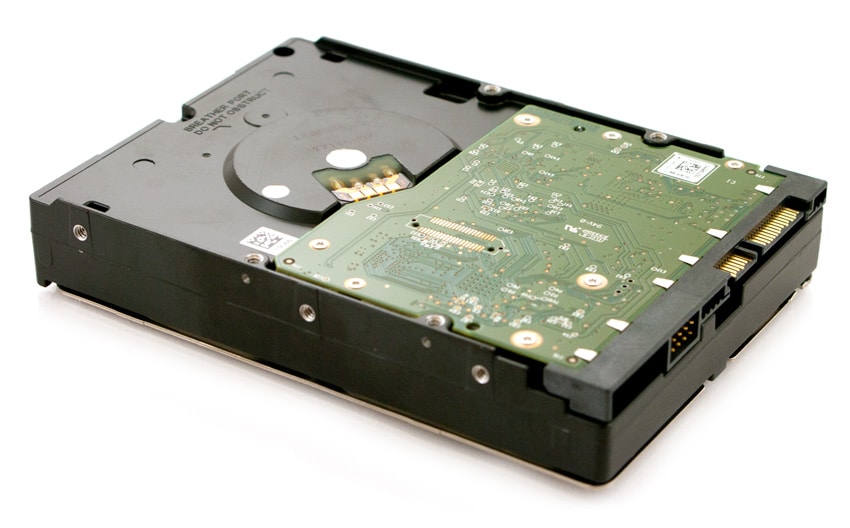
The Western Digital RE 4TB is a standard 3.5″ hard drive based on a SATA 6Gbps interface. We see the standard practice of Western Digital to place the heat-producing components in contact with the body of the drive. This allows things like the controller, RAM, and motor driver to dispense heat into the body acting as a large heat sink. Also, Western Digital makes use of a foam pad placed in between the drive and circuit board to help absorb vibration.

The circuit board includes a Marvell 88i9346 controller, as well as 64MB DDR2 of RAM from the Hynix H5PS5162GFR-S6C module.
Testing Background and Comparables
Comparables for this review:
- 2TB Western Digital RE4
- 3TB Seagate Constellation ES.2
All enterprise HDDs are benchmarked on our enterprise testing platform based on a Lenovo ThinkServer RD240. The ThinkServer RD240 is configured with:
- 2 x Intel Xeon X5650 (2.66GHz, 12MB Cache)
- Windows Server 2008 Standard Edition R2 SP1 64-Bit and CentOS 6.2 64-Bit
- Intel 5500+ ICH10R Chipset
- Memory – 8GB (2 x 4GB) 1333Mhz DDR3 Registered RDIMMs
- LSI 9211 SAS/SATA 6.0Gb/s HBA
Enterprise Synthetic Workload Analysis
Our enterprise hard drive benchmark process preconditions each drive into steady-state with the same workload the device will be tested with under a heavy load of 16 threads with an outstanding queue of 16 per thread, and then tested in set intervals in multiple thread/queue depth profiles to show performance under light and heavy usage. Since hard drives reach their rated performance level very quickly, we only graph out the main sections of each test.
Preconditioning and Primary Steady-State Tests:
- Throughput (Read+Write IOPS Aggregate)
- Average Latency (Read+Write Latency Averaged Together)
- Max Latency (Peak Read or Write Latency)
- Latency Standard Deviation (Read+Write Standard Deviation Averaged Together)
Our Enterprise Synthetic Workload Analysis includes four profiles based on real-world tasks. These profiles have been developed to make it easier to compare to our past benchmarks as well as widely-published values such as max 4K read and write speed and 8K 70/30, which is commonly used for enterprise drives. We also included two legacy mixed workloads, the traditional File Server and Webserver, each offering a wide mix of transfer sizes.
- 4K
- 100% Read or 100% Write
- 100% 4K
- 8K 70/30
- 70% Read, 30% Write
- 100% 8K
- 128K (Sequential)
- 100% Read or 100% Write
- 100% 128K
- File Server
- 80% Read, 20% Write
- 10% 512b, 5% 1k, 5% 2k, 60% 4k, 2% 8k, 4% 16k, 4% 32k, 10% 64k
- Webserver
- 100% Read
- 22% 512b, 15% 1k, 8% 2k, 23% 4k, 15% 8k, 2% 16k, 6% 32k, 7% 64k, 1% 128k, 1% 512k
Our first enterprise workloads, we measured a long sample of random 4K performance with 100% write and 100% read activity to get our main results. The Western Digital RE 4TB measured 139 IOPS read and 208 IOPS write, which closely matches the performance of the Western Digital RE 2TB.
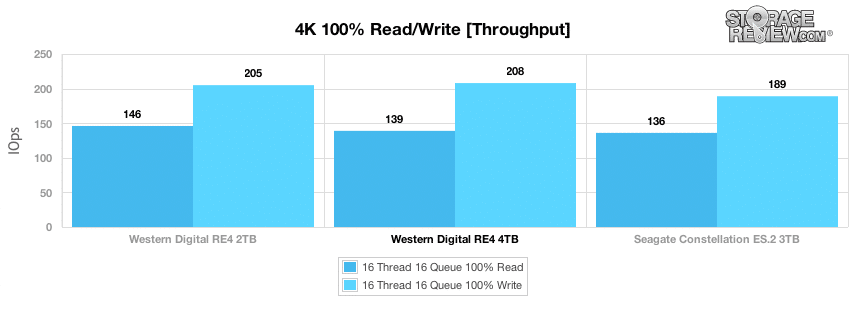
In our main average latency segment with a load of 16T/16Q, we measured an average read latency of 1837.48ms and a write latency of 1224.85ms from the Western Digital RE 4TB.
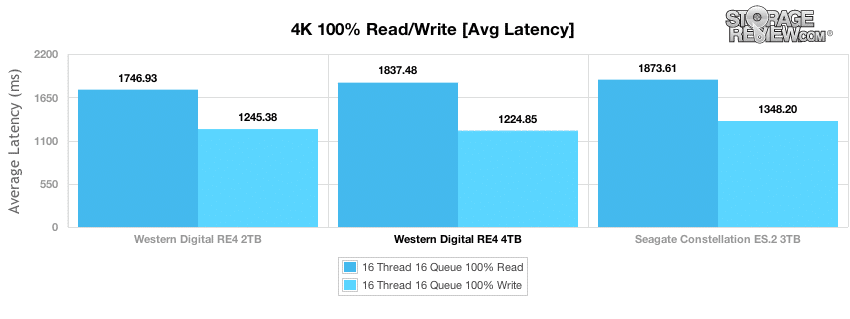
With just read activity, the Western Digital RE 4TB had a max response time of 4904.0ms, although with write activity max latency went up to 2833.0ms.
.
Reviewing the 4K latency consistency in our standard deviation section, the Western Digital RE 4TB came in at bottom of the pack with 497.07ms read standard deviation. It came in at the middle of the pack with 117.70ms write standard deviation. As with the previous 4K performance of 100% write and 100% read activity, the Western Digital RE 4TB matches the performance closely to the older Western Digital RE 2TB drive.
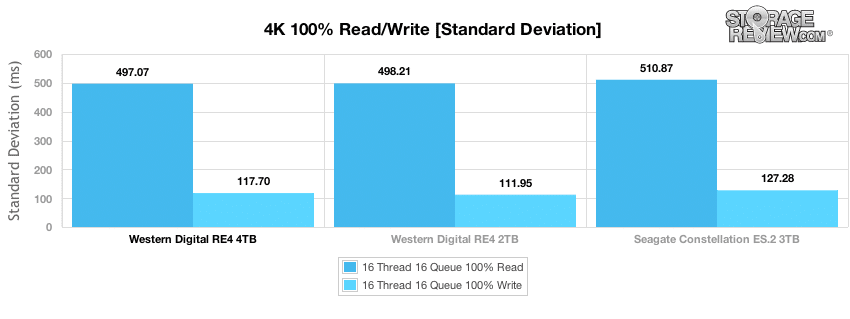
Compared to the fixed 16 thread, 16 queue max workload we performed in the 100% 4K write test, our mixed workload profiles scale the performance across a wide range of thread/queue combinations. In these tests we span workload intensity from 2 threads and 2 queue up to 16 threads and 16 queue. In the expanded 8K 70/30 test, the Western Digital RE 4TB came in the behind the other two drives throughout the test, with the Western Digital RE 2TB leading the pack.
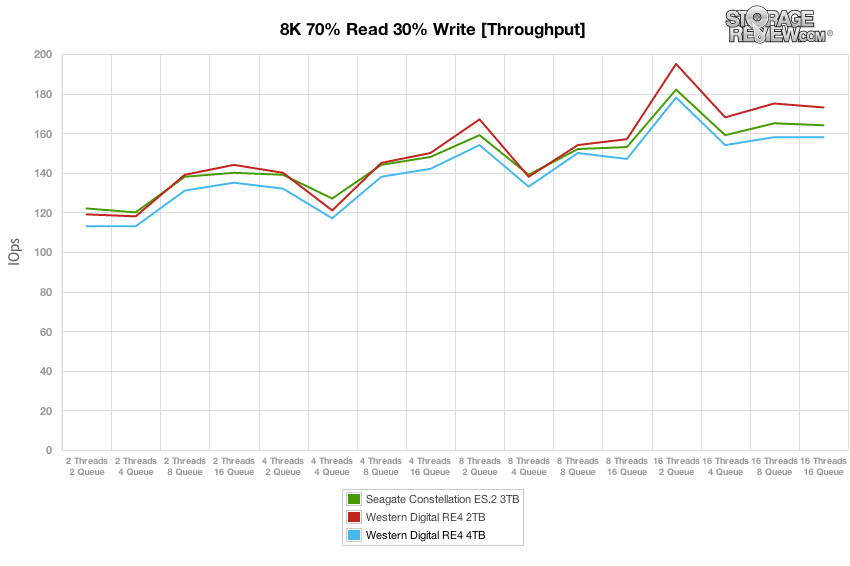
Examining the 8K 70/30 average response times, the Western Digital RE 4TB maintains less than 1000ms average response times up through effective queue depth of 24. It spikes to slightly above 1600ms at an effective queue depth of 32.
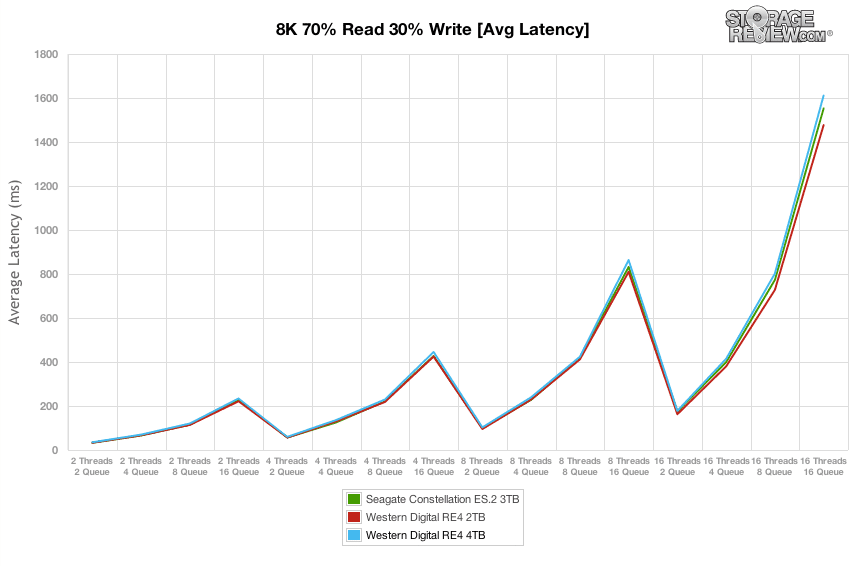
Over the duration of our primary tests at varying thread and queue depth levels, the Western Digital RE 4TB has the lowest max latency of 400ms at 2 threads and 2 queue depth level. At a 16 thread and 16 queue depth level, the Western Digital RE 4TB has the highest max latency of 4,800ms. Throughout the tests, Western Digital RE 4TB performed the best or in middle of the pack, except when reaching the higher thread and queue depth levels.
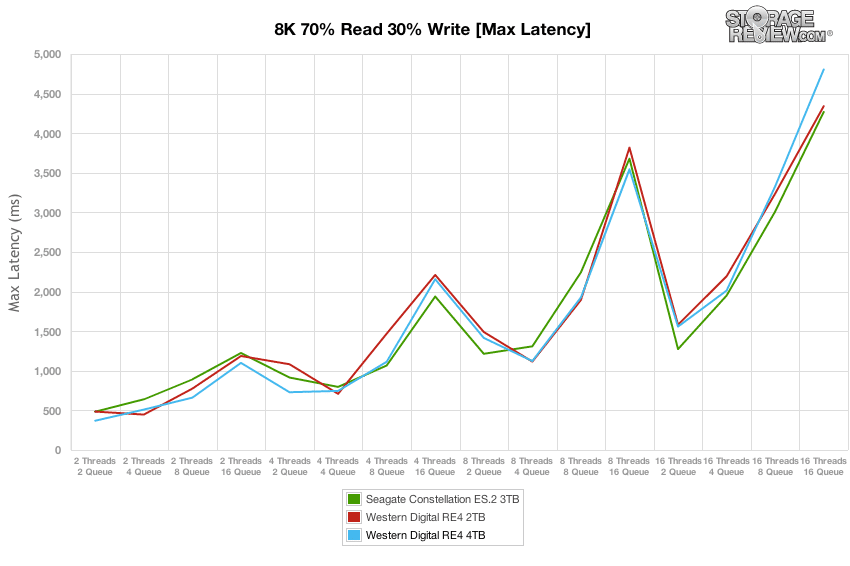
For the entire thread/queue spectrum, the Western Digital RE 4TB kept its latency fairly consistent and in line with the other two drives.
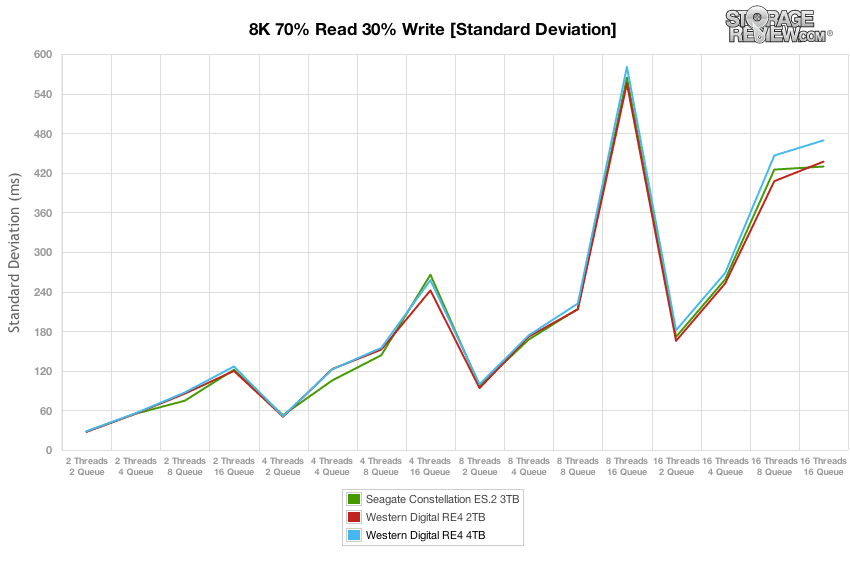
With the Western Digital RE 4TB, we have added a 128K test to our Enterprise Synthetic Workload. The test is a large block sequential test which shows the highest sequential transfer speed for a platter drive. Taking a look at 128K performance of 100% write and 100% read activity, the Western Digital RE 4TB measured 151964 KB/s read and 149886 KB/s write, which outpaces the other drives in both read and write activity.
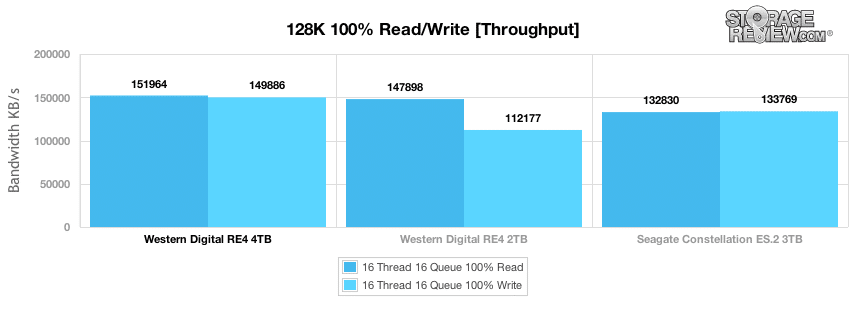
The next workload we used is our File Server profile, putting the drives through a varying workload, where we scaled the thread and queue count from 2T/2Q up to 16T/16Q. In this profile, the Western Digital RE 4TB ranked middle of the pack, while being outpaced by the Western Digital RE 2TB at its peaks, though it slightly outpaced the Seagate Constellation ES.2 3TB at higher thread/queue counts.
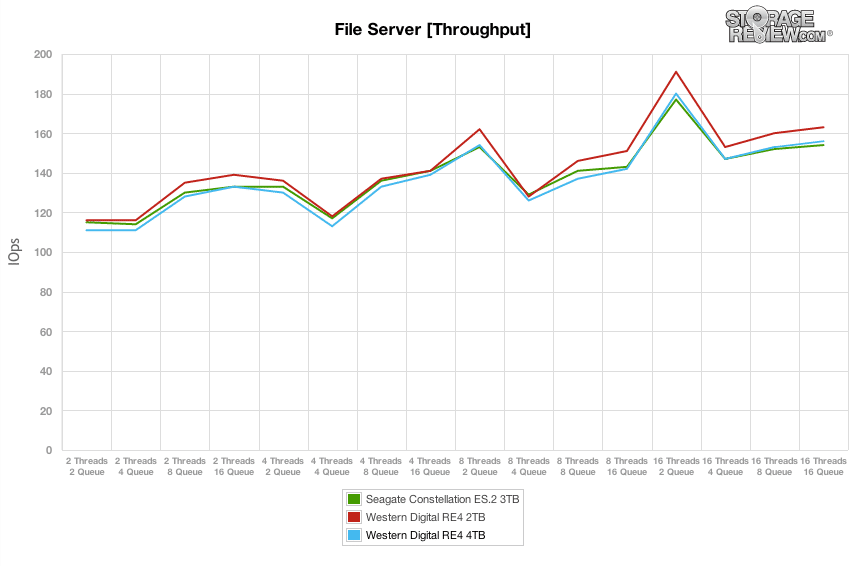
At all effective queue depths, there were no differences between the Western Digital RE 4TB and the other drives we tested. Though above 32 queue depths, the Western Digital RE 2TB separates itself slightly from the pack.
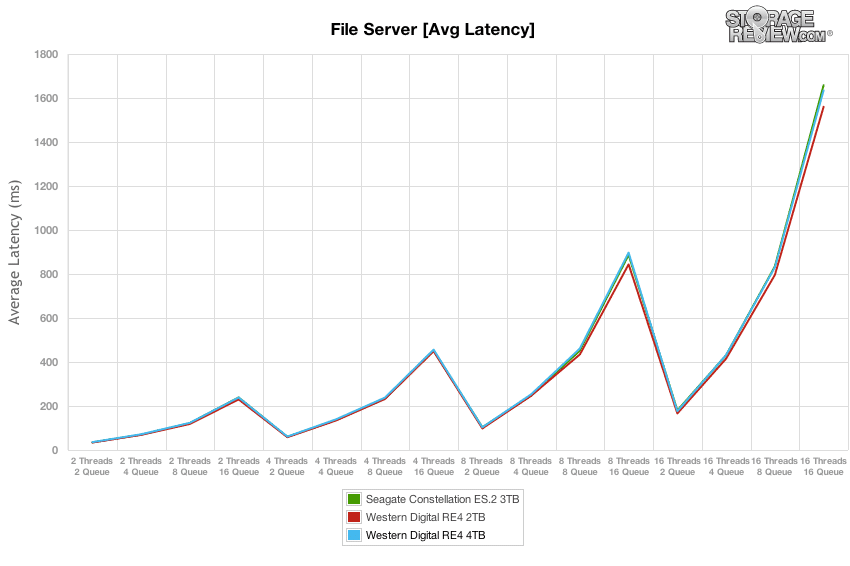
Comparing peak response times in our File Server profile, the Western Digital RE 4TB remains in the middle of the pack, except at queue depth above 32, where it has the highest max latency.
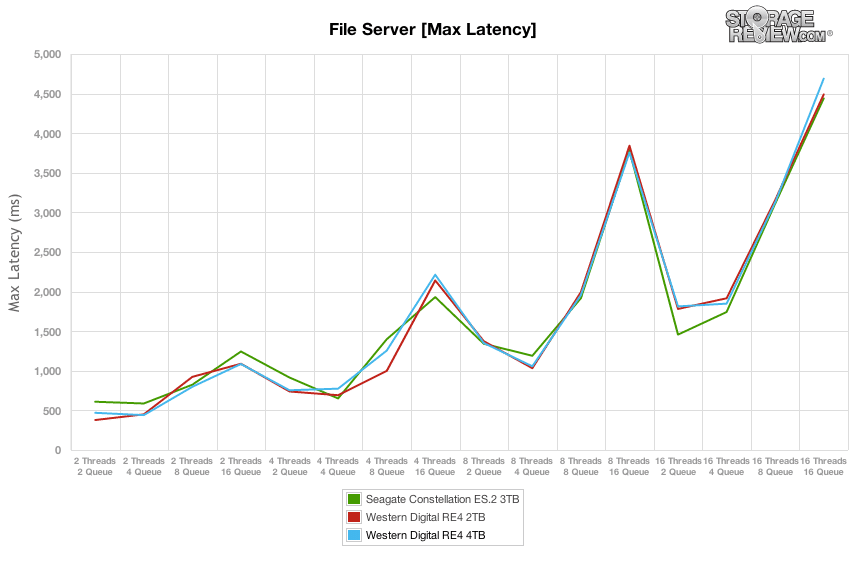
Looking at the latency standard deviation, the Western Digital RE 4TB came in at the bottom of the pack in latency consistency.
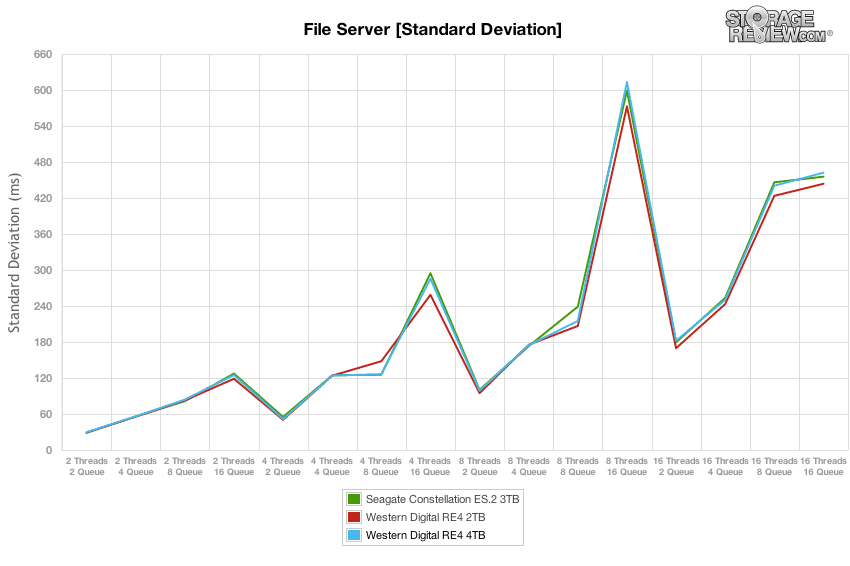
Our final test is the Web Server test, which is traditional 100% read activity. The Western Digital RE 4TB also performs in the middle of the pack, once you hit an effective queue depths of 16 or above.
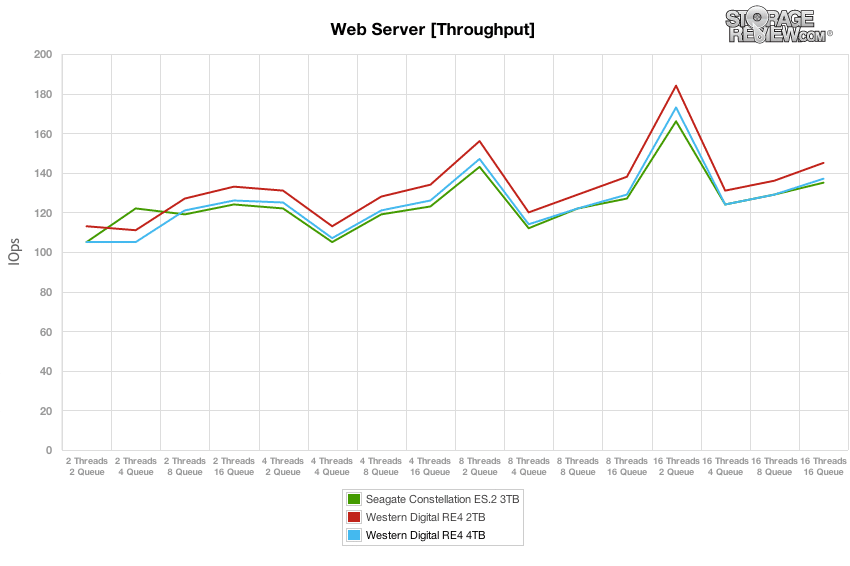
At effective queue depth loads below 32, the Western Digital RE 4TB maintained an average response time of under 1000ms in our Web Server workload. The Western Digital RE 4TB matches the performance of the Seagate Constellation ES.2 3TB, almost identically, with the Western Digital RE 2TB leading the pack.
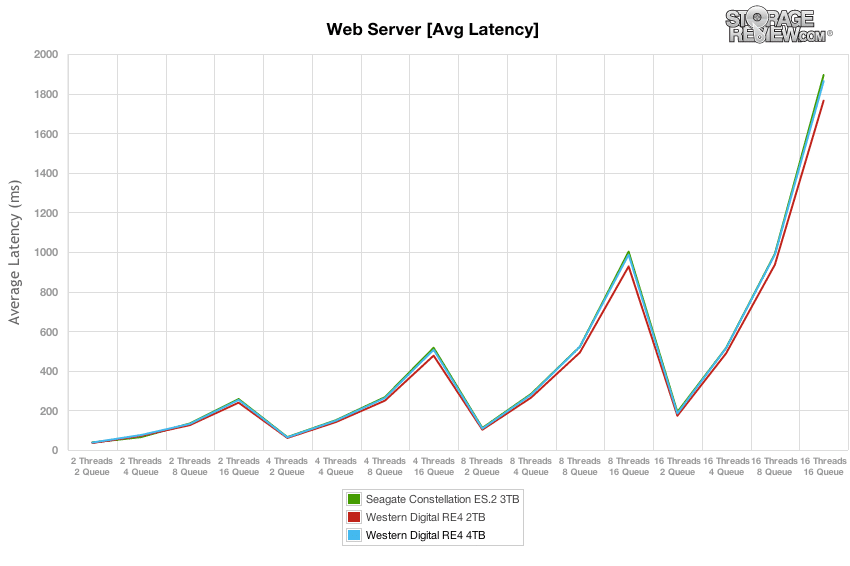
For the duration of the varying loads in our Web Server profile, the Western Digital RE 4TB was outpaced by both drives, by offering the highest max latencies at effective queue depths of 8 or above.
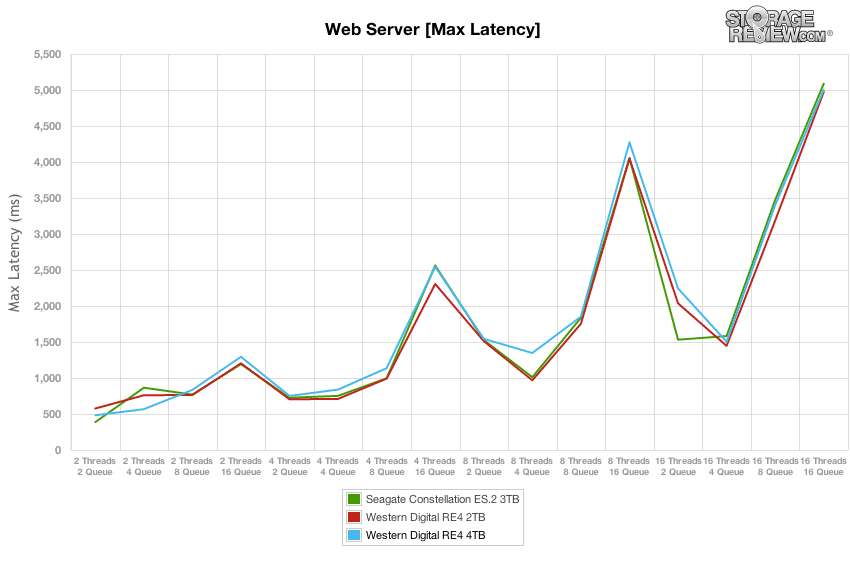
Comparing latency consistency in our read-only Web Server profile, the Western Digital RE 4TB matches the performance of the Seagate Constellation ES.2 3TB, almost identically.
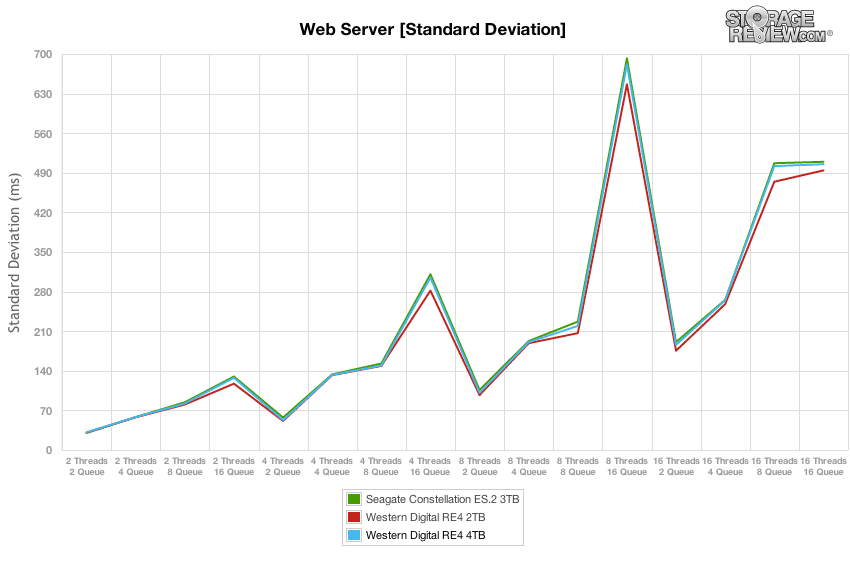
Conclusion
The Western Digital RE 4TB with its top-tier capacity is a welcome addition to the rich family tradition of the Western Digital RE drives. These Western Digital drives are built for the Enterprise users looking for performance while maintaining reliability and the ever expanding capacity requirements to meet your needs. With Western Digital’s track record on its RE drives, there’s no reason to expect anything less from the Western Digital RE 4TB Enterprise drive.
Throughout all of our Enterprise Synthetic Workload test, the Western Digital RE 4TB performance is on par with the other enterprise class hard drives we tested: Western Digital RE 2TB and Seagate Constellation ES.2 3TB. The Western Digital RE 4TB did very well under our new 128K test which is designed to show the best case scenario for hard drives. We were able to see the true potential of the larger capacity updated RE, it easily outpaced the other two drives in read performance and showed significant improvement in write performance.
One of the major concerns for IT professional, is the reliability of the product and the likely hood the drive will crash or corrupte their data. Though the track record of the Western Digital RE drives have been good, it is interesting to note that it also has the lowest Mean Time Between Failures (MTBF) in its class at 1.2 million hour MTBF. The newer Seagate Constellation ES.3 offers a 1.4 million hour MTBF and Western Digital’s own HGST Ultrastar 7K4000 brand offers a 2.0 million hour MTBF. This doesn’t mean that the RE will actually fail more often, however it’s worth noting the MTBF quote lags the industry substantially.
Pros
- Higher sequential transfer speeds than 2TB RE
- High Capacity – 4TB
Cons
- Outpaced in some places by the Western Digital RE 2TB drive
- Lower Mean Time Between Failures (MTBF) than competition
Bottom Line:
The Western Digital RE SATA 4TB provides fast, and reliable performance with the largest available capacity and will give enterprise users a density boost for bulk storage applications.
WD RE 4TB at Amazon.com

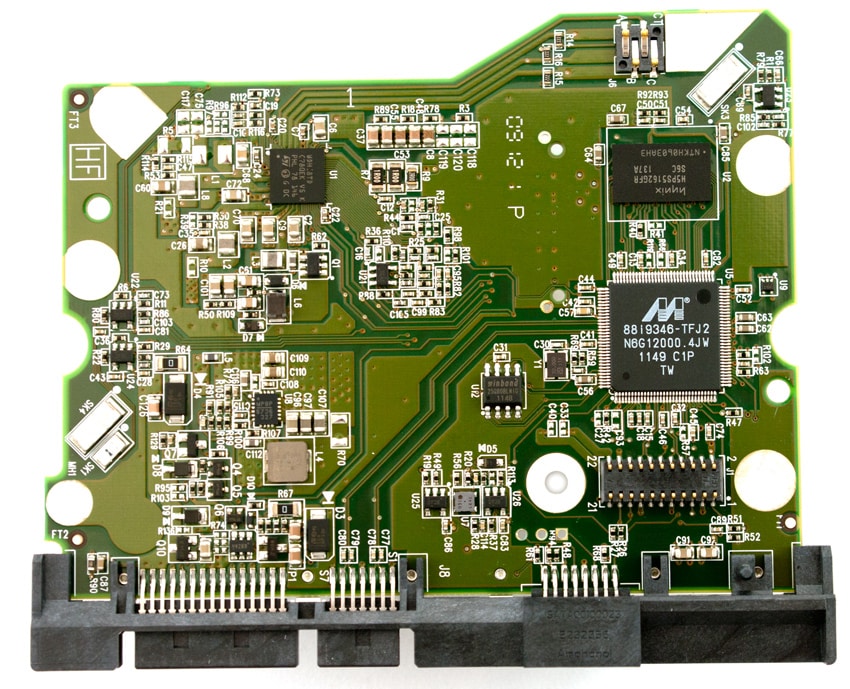
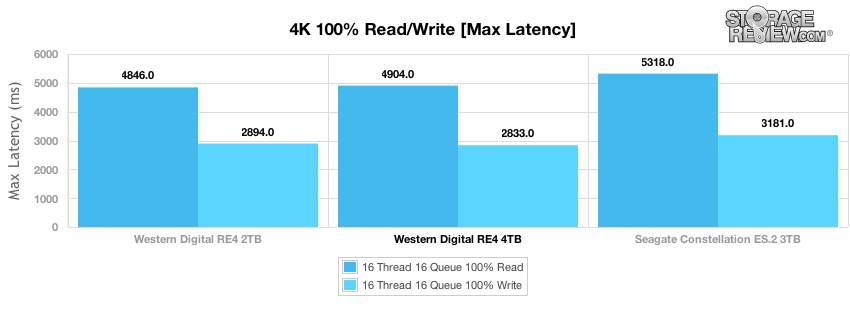


 Amazon
Amazon